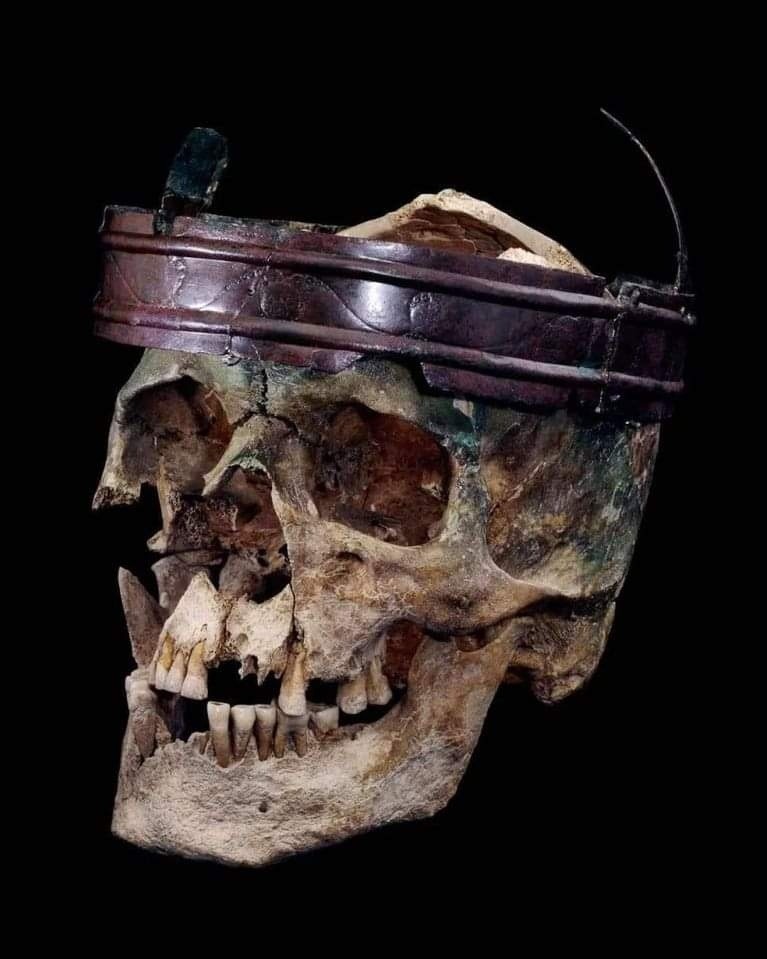In a remarkable archaeological discovery, the Mill Hill Crown, a copper alloy artifact dating back to approximately 250-150 B.C., was unearthed near Deal, England, at Mill Hill. This extraordinary find has captured the imagination of historians and archaeologists alike, as the crown was discovered perfectly intact and still adorning the skull of its original owner. Now housed in the prestigious British Museum, this ancient treasure continues to fascinate visitors with its historical significance and stunning craftsmanship.
The Mill Hill Crown is a shining example of the extraordinary skills possessed by ancient artisans. Intricately detailed with ornate motifs and delicate engravings, the crown demonstrates the remarkable artistic abilities of its creators. The fine patterns and precise workmanship offer a glimpse into the cultural and aesthetic sensibilities of the society that produced it. Every curve and design element reflects the high standards of artistry that were valued during the era, making the crown not only a functional item but also a work of art.

One of the most intriguing aspects of the Mill Hill Crown is its implication of the wearer’s status. The fact that it was found still adorning the skull of its original owner strongly suggests that the individual held a position of significant social importance. Whether a political leader, a religious figure, or a person of ceremonial prominence, the crown’s presence indicates a role that was highly respected within their community. The rarity of discovering such an artifact in situ only adds to the mystery surrounding the individual and their life in ancient society.
The discovery of the Mill Hill Crown opens a window into a past that is both enigmatic and enlightening. It raises questions about the individual buried with such an extraordinary item. Who were they? What was their role in their community? What events led to their burial with this symbol of high status? While the answers remain elusive, ongoing research and advanced analysis techniques may eventually provide insights into the identity and significance of this fascinating figure from history. These questions, though unanswered, fuel the imagination and inspire further study, highlighting the richness of the ancient world and its many untold stories.
Today, the Mill Hill Crown is proudly displayed at the British Museum, where it continues to captivate audiences from around the world. As part of a larger collection of artifacts from diverse periods and cultures, the crown serves as a tangible connection to our shared human heritage. Visitors to the museum can marvel at its beauty and craftsmanship while contemplating the stories of the people who lived thousands of years ago. The crown’s presence in such a prominent institution underscores its importance as a historical artifact and a symbol of ancient ingenuity.
The preservation of the Mill Hill Crown and its inclusion in the British Museum’s collection also highlight the essential role of archaeology in uncovering and protecting our past. Through meticulous excavation, documentation, and conservation, this remarkable artifact has been safeguarded for future generations to study and appreciate. It stands as a reminder of the enduring value of archaeological discoveries in enriching our understanding of human history and culture.
The Mill Hill Crown is more than just an ancient object; it is a testament to the enduring fascination and importance of uncovering the stories of those who came before us. Its intricate design, historical significance, and the mysteries surrounding its owner combine to create a compelling narrative that continues to captivate and inspire. This relic of ancient majesty offers a glimpse into a world long gone but not forgotten, reminding us of the ingenuity, artistry, and social structures that shaped the lives of our ancestors.
Through the study of artifacts like the Mill Hill Crown, we gain a deeper appreciation for the complexities of ancient civilizations. Each discovery provides a piece of the puzzle, helping to build a more comprehensive picture of humanity’s journey through time. The crown, with its exquisite craftsmanship and enigmatic history, serves as a symbol of this ongoing quest for knowledge. It encourages us to look beyond the present and consider the legacy of the past, fostering a greater understanding of our shared human experience.
The significance of the Mill Hill Crown extends beyond its immediate historical and artistic value. It represents the enduring curiosity and dedication of archaeologists who work tirelessly to uncover the secrets of the past. Their efforts ensure that treasures like this crown are preserved and studied, offering insights that enrich our understanding of history and culture. The crown’s journey from the burial site to the museum is a testament to the importance of preserving our heritage for the benefit of future generations.
As visitors stand before the Mill Hill Crown in the British Museum, they are reminded of the profound connection we share with those who lived centuries ago. The crown’s delicate engravings and intricate designs speak of a time when craftsmanship was a revered skill, and objects of beauty were imbued with deep cultural significance. It is a powerful reminder of the creativity and ingenuity that have defined humanity throughout the ages.
In conclusion, the Mill Hill Crown is a remarkable artifact that embodies the artistry, mystery, and historical importance of the ancient world. Its discovery has provided invaluable insights into the lives of those who lived over two millennia ago, while its preservation ensures that future generations can continue to learn from and be inspired by this extraordinary piece of history. As it sits on display at the British Museum, the Mill Hill Crown stands as a symbol of our enduring fascination with the past and the stories it has yet to reveal.





